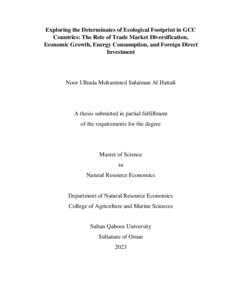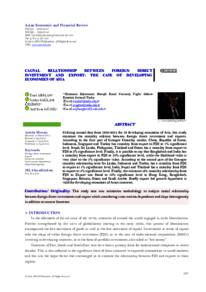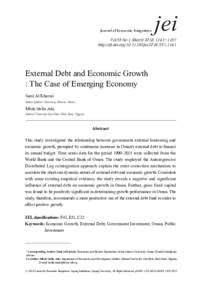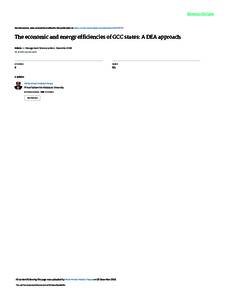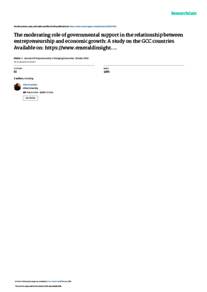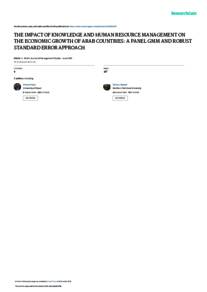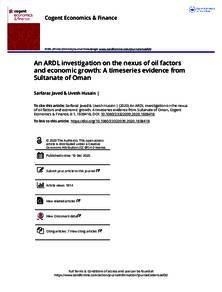وثيقة
Exploring the determinates of ecological footprint in GCC countries : the role of trade market diversification, economic growth, energy Consumption, and foreign direct investment.
عناوين أخرى
اكتشاف محددات البصمة البيئية في دول مجلس التعاون الخليجي : دور تنويع الأسواق التجارية، والنمو الاقتصادي، واستهلاك الطاقة، والاستثمار الأجنبي المباشر
الناشر
Sultan Qaboos University.
ميلادي
2023
اللغة
الأنجليزية
الموضوع
الملخص الإنجليزي
The mounting interest in the environment triggered the ' 'scholar's attention and effort to
study the determinants of environmental degradation and quality. Precedently, researchers
employed CO2 emissions as a proxy for environmental degradation. However, this
indicator is encountered insufficient in capturing resource use levels and pollution damage
to different aspects of the ecosystem. As a result, the ecological footprint concept is a
holistic measure of environmental degradation, as it can encompass the resource
consumption and pollution of six land types, including cropland, grazing land, fishing
ground, built-up land, forest, and carbon land. The ecological Footprint has evolved from
a two-dimensional representation of resource consumption and pollution to a three dimensional model, including resource use and pollution, as well as the time (years)
difference between biological regeneration and human consumption.
This study is carried out to explore the effect of trade market diversification, economic
growth, energy consumption, and foreign direct investment on the two-dimensional and
three-dimensional ecological Footprint in Gulf Cooperation Council (GCC) countries
using 19 years (2000-2018) data base. The Im, Pesaran, and Shin (IPS) panel unit root test
was implemented to check the stationarity of the variables, followed by investigating the
existence of the long-run relationship through the Padroni cointegration test. The pooled
mean group-autoregressive distributed lags (PMG-ARDL) estimator was used to estimate
the long-run and short-run coefficients for the two models of ecological Footprint.
Our results showed that the influence of the explanatory variables: trade market
concentration, foreign direct investment, economic growth, and energy consumption
increase environmental degradation in the long run. The Environmental Kuznets Curve
(EKC) hypothesis was proved in the long run for the two-dimensional model, indicating
that the GCC countries, in the long run, will reach the third phase of the EKC, where
pollution will decrease while continuing economic growth. In other words, an additional
increase in the GCC countries' income will simultaneously reduce environmental
degradation and resource use. This study recommends that the GCC countries diversify
their export partners as the trade (export) concentration accelerates environmental
degradation. Additionally, the GCC countries should establish more stringent
environmental regulations and attract foreign cleaner industries apart from the petroleum
sector., The GCC countries would need to switch to renewable and cleaner energy sources
to achieve a zero-carbon goal by 2050.
المجموعة
URL المصدر
الملخص العربي
تٌعد الادارة المستدامة للموارد والحفاظ على البيئة من بين الاولويات القصوى لقادة وصانعي السياسات في الدول حيث أثار الاهتمام المتزايد بالبيئة الى توجه جهود الباحثين لدراسة التدهور البيئي و / أو جودة البيئة. وأشارت الدراسات السابقة الى استخدم الباحثون انبعاثات ثاني أكسيد الكربون كمؤشر للتدهور البيئي. عالوة إلى ذلك فقد وجد أن هذا المؤشر غير كا ٍف في تحديد مستويات استخدام الموارد الطبيعية وأضرار التلوث التي تلحق بالجوانب المختلفة من النظام البيئي. ويعتبر مفهوم البصمة البيئية من المفاهيم الشمولية لقياس التدهور البيئي والذي يشمل الاتي: استهالك الموارد والاراضي الملوثة من بينها الاراضي الزراعية، والاراضي العمرانية، وأراضي الرعي، وأراضي الخث، والغابات ومناطق الصيد. تطورت البصمة البيئية من نموذج ثنائي الابعاد إلى نموذج ثالثي الابعاد، حيث يمثل النموذج ثنائي الابعاد استهالك الموارد وتلوثها فقط، في حين أن النموذج الثالثي الابعاد يتضمن عنصر استهالك الموارد وتلوثها وتجددها. ولهذه الاسباب تم إجراء هذه الدراسة الستكشاف تأثير تنويع الاسواق التجارية والنمو الاقتصادي واستهالك الطاقة والاستثمار الاجنبي المباشر على البصمة البيئية الثنائية والثالثية الابعاد في دول مجلس التعاون الخليجي لمدة 19 سنة )2018-2000(. حيث تم تنفيذ منهجية IPS -Shin ,Pesaran ,Im )(للتحقق من ثبات المتغيرات، متبو ًعا باستخدام منهجية )test cointegration Padroni )للتحقق من وجود عالقة طويلة المدى بين المتغيرات. ثم استخدام منهجية (ARDL-PMG (لتقدير المعامالت طويلة المدى وقصيرة المدى لنموذجي البصمة البيئية. وبنا ًء على ذلك، خلصت الدراسة إلى وجود عالقة طويلة المدى بين المتغيرات المدروسة حيث يؤدي تركيز التصدير الى أسواق عالمية قليلة والاستثمار الاجنبي المباشر واستهالك الطاقة إلى زيادة التدهور البيئي. بالاضافة تم إثبات فرضية منحنى كوزنتس البيئي (EKC (على المدى الطويل للنموذج ثنائي الابعاد، مما يشير إلى أن دول مجلس التعاون الخليجي، على المدى الطويل، سوف تصل إلى المرحلة الثالثة من )EKC )والتي تعمل على تقليل التلوث مع زيادة النمو الاقتصادي. وبعبارة أخرى، فإن الزيادة الاضافية في دخل دول مجلس التعاون الخليجي ستؤدي إلى تقليل التدهور البيئي في المدى البعيد. أوصت هذه الدراسة قادة دول مجلس التعاون الخليجي وواضعي السياسات بتنويع وجهات التصدير ألن التركيز يسرع من التدهور البيئي. بالاضافة إلى ذلك يجب أن يكون هناك قوانين بيئية صارمة فيما يتعلق بالاستثمار الاجنبي وجذب المستثمرين إلى صناع ات صديقة للبيئة بخالف قطاع البترول. وأخيرا التركيز على موارد طاقة متجددة كبديل للوقود الاحفوري لتحقيق الحياد الصفري الكربوني بحلول .2050
قالب العنصر
الرسائل والأطروحات الجامعية

